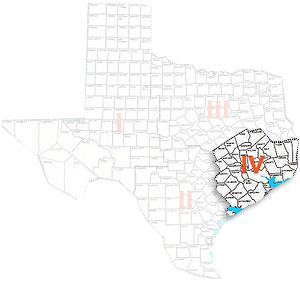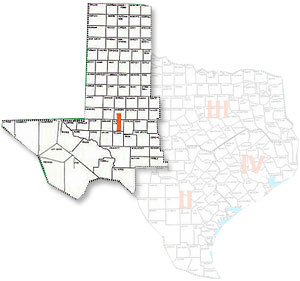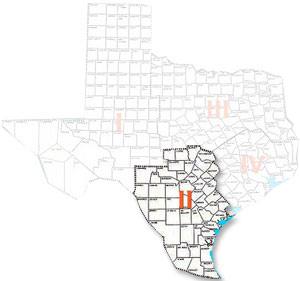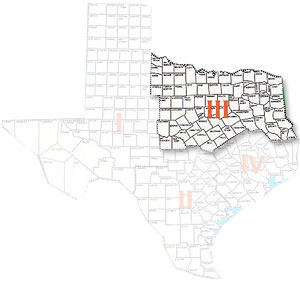AIPG District IV – Southeast Texas
District IV Representative – Texas Section AIPG
Matthew R. Cowan, P.G., Houston, Texas
This page represents the activities of the American Institute of Professional Geologists in the South-East District IV of Texas. This District is geologically complex and contains abundant oil and gas resources, lignite, uranium and other natural resources. Such resources have allowed Texas to develop a diversified range of high-technology driven petrochemical and related industries as well as a sound agricultural base, both with environmental awareness and effective regulation.
Oil & Gas Exploration & Development
District IV covers the south-eastern part of Texas, which includes Houston, the nerve center for the worldwide petroleum industry, and Beaumont, where the petroleum age dawned on 10:30 in the morning on January 10, 1901. The great American oil producer "roared in like a shot from a heavy cannon and spouted oil a hundred feet over the top of the wooden derrick from what the world would soon know as the Spindletop oil field." The world began to change rapidly as this new source of energy, petrochemicals, and medicine gained the favor of American industry as well as in countries overseas.
Delta-system reservoirs dominate coastal plays of the south-eastern part of Texas. The porosity and permeability of these geologically young reservoirs are high, reflecting the unconsolidated condition of the sands of Eocene age. More than twelve fields have been identified to date.
For additional information on oil & gas and other resources and related environmental aspects of East Texas, see the Web site of the Houston Geological Society (here).
Lignite/Coal Exploration & Development
The northern part of this district has, over the past 20 years, also had an important role in lignite exploration and mining. Centered in North-East Texas but extending into parts of the South-East District, a number of companies are currently mining lignite. Production for 1996 was approximately 53 million tons. This makes Texas the 5th largest coal producer in the nation, The lignite is mined from the Wilcox Group (Paleocene-Eocene) and other Tertiary fluvial units.
In Texas, about 98% of all lignite mined is used for electric power generation. Approximately 27% of the electricity generated in Texas is from lignite. Texas imports 24% of its coal from several western states and is the largest consumer of coal in the nation, burning 93 to 94 million tons per year. According to the Bureau of Economic Geology of Texas, the demonstrated reserve base of surface mineable lignite is sufficient to fuel electric generation for at least 100 years. The mining industry in Texas is a mature and healthy industry, providing substantial economic support to the state's economy.
Uranium Resources
Upper Eocene and Miocene fluvial sediments host Tertiary-age "roll-front" uranium deposits in south Texas, which may extend into southeast Texas. Uranium mining (both open pit and in-situ mining) and yellow-cake production were initiated in the 1970's and have continued sporadically since then.
Geothermal Resources
Geopressured geothermal resources were identified in the 1970's and attempts at development and commercialization were attempted with only limited success. This resource awaits development.
Texas Mineral Resources (here)
Environmental Issues:
Water Supplies
In a population of rapid growth, nearly full employment, and a free economy, Texas residents debate the age-old conflict between industrial development and the status quo, resource utilization and appropriate management, and associated environmental issues. But population growth and economic development, coupled with a climate in which surface-water resources are scarce, have imposed real and potential water-supply problems in many areas of Texas. In much of Texas, available surface storage capacity in existing reservoirs will barely be sufficient to meet water demands of continued industrialization and urban development, especially during critical droughts which are common occurrences over the long term.
Extensive development of the readily available ground water has progressed rapidly over the past 20 years but has resulted in several problems, some local in nature, while others are more widespread. Problems of water quality, both from natural and man-made causes (e.g. nitrates), are expected to affect the suitability for use of water from portions of Texas' aquifers in the future. Natural pollution, primarily sodium chloride, results from salt springs and salt flats within drainage areas of the basins. In some areas, this problem has been aggravated to some extent by oil and gas exploration and production activities. Mining has also been indicated as contributing to pollution. Balancing resources and local needs to maintain economic growth and development are the primary goals in Texas.
More than 50 percent of Texas in underlain by seven major aquifers and 16 minor aquifers. Because of industrial and urban development, long-term use of ground water is lowering water levels to the extent costs of production are increasing rapidly. Surface-water reservoirs are being developed in south-eastern Texas, and elsewhere, to offset the foreseeable problems of the future.
Index to Superfund Sites by County
If a county does not appear on this list, it is because there is no state or federal Superfund site in that county. This index includes all sites – those where cleanup is complete as well as those for which cleanup or assessment is in progress (here).
On the county maps, a light blue star designates a federal Superfund site. A red star designates a state Superfund site.
Major Report on Houston Area Faulting & Groundwater (here).
References:
Search Results for "Texas" (New)
Older References of Interest:
Spearing, D., 1991, Roadside Geology of Texas, Mountain Press Publishing Company, Missoula, MT, 418 p.
Fisher, W. L. , and W. E. Galloway, 1983, Potential for Additional Oil Recovery in Texas, Bureau of Economic Geology Geological Circular 83-2, pp. 6-7.
Campbell, M. D., M. David Campbell, H. M. Wise, and R. C. Bost, 2014, Growth Faulting and Subsidence in the Houston, Texas Area, has been completed and released after more than 10 years of research and discussions among the geological community in the Houston area (more). The Guide is consistent with the goals of the IET Sponsored Research Program (more) established in the mid-1990s to provide ongoing technical support to the graduates of the IET program and other interested professionals within the Houston Geological Society and to members of the AIPG in Texas and elsewhere.
Campbell, M. D., and K. T. Biddle, 1977, Chapter 1: Frontier Exploration-Uranium, in Geology Alternate Energy Resources in South-Central United States, Houston Geological Society, M. D. Campbell (ed), pp. 3-44. (PDF)
Dickinson, K. A., and J. S. Duval, 1977, Chapter 2: Trend Exploration-Uranium, in Geology Alternate Energy Resources in South-Central United States, Houston Geological Society, M. D. Campbell (ed), pp.45-66. (PDF)
Wielchowsky, C. C., et al., 1977, Chapter 6: Frontier Exploration-Lignite, in Geology Alternate Energy Resources in South-Central United States, Houston Geological Society, M. D. Campbell (ed), pp.125-159.
Bebout, D. G., 1977, Chapter 12: Trend Exploration-Geopressured Geothermal Energy, in Geology Alternate Energy Resources in South-Central United States, Houston Geological Society, M. D. Campbell (ed), pp. 251-273.
Kallus, M. F., 1977, Chapter 4: Environmental Considerations-Uranium, in Geology Alternate Energy Resources in South-Central United States, Houston Geological Society, M. D. Campbell (ed), pp. 83-109.
Hirsch, A. M., 1977, Chapter 9: Environmental Considerations-Lignite, in Geology Alternate Energy Resources in South-Central United States, Houston Geological Society, M. D. Campbell (ed), pp. 193-202.
Gustavson, T. C. and C. W. Kreitler, 1977, Chapter 14: Environmental Considerations-Geopressured Geothermal Energy, in Geology Alternate Energy Resources in South-Central United States, Houston Geological Society, M. D. Campbell (ed), pp. 297-336.
Evans, T. J., 1974, Bituminous Coal in Texas, Bureau of Economic Geology Handbook 4, 65 p.
Kaiser, W. R., et.al., 1980, Lignite Resources in Texas , Bureau of Economic Geology Report of Investigations No. 104, 52 p.
Bebout, D. G., et al., 1976, Geothermal Resources , Frio Formation, Upper Texas Gulf Coast, Bureau of Economic Geology Geological Circular 76-3, 47 p.
Jones, D. C., 1973, An Investigation of the Nitrate Problem in Runnels County, Texas, Texas Water Development Board, EPA-R2-73-267, June, pp. 6-7.
Brown, L. F., et al., 1976, Environmental Geologic Atlas of Texas Coastal Zone-Corpus Christi Area, Bureau of Economic Geology, 123 p.
Bebout, D. G., et al., 1976, Geothermal Resources, Frio Formation, Upper Texas Gulf Coast, Bureau of Economic Geology Geological Circular 76-3, 47 p.
Dorfman, M., and R. O. Kehle, 1974, Potential Geothermal Resources of Texas, Bureau of Economic Geology Geothermal Circular 74-4, 33 p.
Smith, G. E., et al., 1982, Regional Hydrodynamics and Hydrochemistry of the Uranium-Bearing Oakville Aquifer (Miocene) of South Texas, Bureau of Economic Geology Report of Investigations No. 124, 31 p.
Galloway, W. E., et al., 1982, Depositional Framework, Hydrostratigraphy, and Uranium Mineralization of the Oakville Sandstone (Miocene), Texas Coastal Plain, Bureau of Economic Geology Report of Investigations No. 113, 51 p.
Collins, E. W., et al., 1980, Quaternary Faulting in East Texas, Bureau of Economic Geology Geological Circular 80-1, 20 p.
Anon., 1984, Water for Texas: A Comprehensive Plan for the Future, November, Texas Dept. of Water Resources GP-4-1, 72 p.
Ashworth, J. B., and J. Hopkins, 1995, Aquifers of Texas, Texas Water Development Board Report 345, November, 69 p.
In The News
Sponsors of the AIPG-TX GEODAYZ Training Program
2022
2018



























